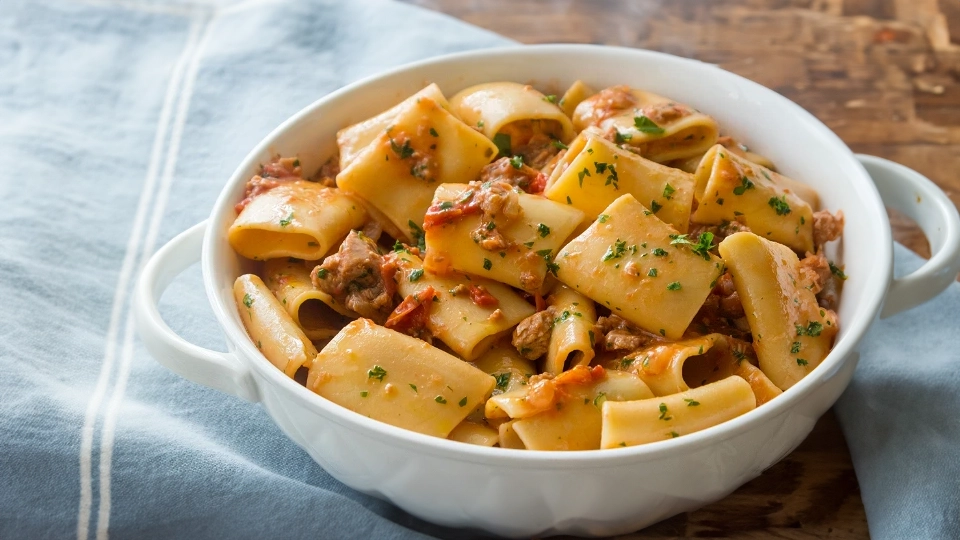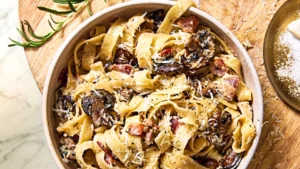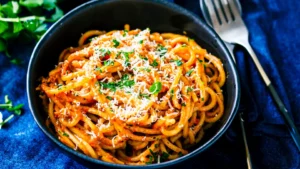I’ve always believed that the best way to experience a country’s culture is through its food. There’s something about the way a simple dish can encapsulate the history, traditions, and values of a place. For centuries, Tuscany has been celebrated for its robust and flavorful cuisine, and one of its most renowned culinary offerings is the humble Pappa Al Pomodoro, or Tuscan bread soup.

In this extensive guide, I’m inviting you to join me on a culinary excursion through the winding streets of Tuscany as we uncover the secrets of this staple dish. Far from a mere recipe, this post is a testament to the ingredients, techniques, and stories that make Tuscan bread soup a quintessential part of Tuscan life.
Tuscan Bread Soup

Ingredients
The beauty of Tuscan bread soup lies in its simplicity. Just a handful of staple ingredients come together to create a soup that’s rich in flavor and steeped in history.
- 4 cups ripe tomatoes, peeled and chopped (or 2 cans of diced tomatoes)
- 6 cups day-old crusty bread, torn into pieces
- 1/4 cup extra virgin olive oil, plus more for drizzling
- 2 cloves garlic, minced
- 1 medium onion, diced
- 2 cups vegetable broth or water
- 1/2 cup fresh basil leaves, chopped
- Salt and pepper to taste
- Parmesan cheese, grated (optional, for serving)
Instructions
With the ingredients gathered, it’s time to begin the alchemy of turning them into Tuscan bread soup. This process, like the best recipes, is both art and science.
Step 1 – Tomatoes and Bread
Start by boiling a pot of water. Score the tomatoes with a cross at the base, then blanch them for a minute and transfer them into ice-cold water. This will make it easy to peel the skin off. Next, chop them and pass them through a food mill to get rid of the seeds.
Now, cut or tear the bread into large chunks. The traditional method involves using stale bread to avoid fogginess, as fresh bread can disintegrate too quickly. However, soaking stale bread in your tomato mixture can revive it, creating a textural delight.
Step 2 – The Aromatics
In a separate pan, heat olive oil over medium heat. Add finely chopped onion and garlic, and sauté until they turn a pale golden color. The aromas that fill your kitchen at this stage are the prelude to the soup’s deep flavor.
Step 3 – Bringing it All Together
Into the pan of aromatic golden goodness, add the tomato puree. Stir it well to incorporate, then introduce the bread chunks. Season to taste with salt, pepper, and a hint of sugar to balance the acidity of the tomatoes.
Turn up the heat and add the vegetable broth to loosen the mixture. You want it thick and substantial, but still a soup, not a stew.
Step 4 – Simmer and Stir
Reduce the heat and allow the soup to simmer gently for about 30 minutes, stirring occasionally to prevent the bread from sticking to the bottom. The bread should have broken down and integrated with the tomatoes, creating a ‘pappare’, which roughly translates to a thick, coarse texture in Tuscan dialect.
Step 5 – The Finale
Just before you’re ready to serve, tear fresh basil leaves and add them to the pot. This not only imparts flavor but also paints your Tuscan bread soup with vibrant green, a color that sharpens one’s appetite and senses.
The final result should be a rich, tomato-red soup, flecked with green basil, and aromatic steam that whispers promises of warmth and comfort.

DID YOU MAKE THIS RECIPE?
Tag @amcookingitaliano on Instagram and hashtag it #amcookingitaliano!
Tips for Customization
While traditions are grounding, they also leave room for personal touches. Tuscan bread soup is a versatile recipe that can adapt to different tastes and dietary needs.
Making it Vegan or Gluten-Free
For a vegan version, simply omit the Parmesan rind and ensure your bread is without any animal by-products. Substitute the vegetable broth with water or a flavorful mushroom broth.
To make it gluten-free, swap out the bread for a gluten-free alternative. Rice bread or a sturdy gluten-free loaf will suit the recipe well.
Adding Protein and Veggies
For those looking to increase the protein content, consider adding cooked chickpeas or white beans. They blend effortlessly into the soup, making it heartier and more nutrient-dense.
You can also add vegetables like zucchinis, carrots, or celery. Dice them into small pieces and cook them slightly longer with the onion and garlic to soften them before adding the tomatoes.
Spice it Up
If you crave a spicier edge, experiment with different types of chili or some harissa paste for a North African twist. Just be mindful of the heat level, so it doesn’t overpower the other delicate flavors.
How to Store
Pappa Al Pomodoro gets better with time. Allow the soup to cool completely and store it in an airtight container in the refrigerator for up to three days. Like magic, the flavors will intensify and the soup will thicken further, presenting a refreshingly different but equally delightful version when reheated.
Conclusion
Cooking Pappa Al Pomodoro is more than the act of combining ingredients. It’s a chance to connect with centuries-old culinary heritage, to invite the essence of Tuscany into your home, and to savor the simple and soulful flavors that have stood the test of time.
Next time you’re perusing your local farmers’ market or eyeing the heirloom tomatoes at your grocery store, think of Pappa Al Pomodoro. This post serves as a sacred text, a guidebook for crafting a soup that is not just food, but a legacy on a ladle.
I hope you try your hands at making this Tuscan treasure. Whether it’s a winter warmer or a summer delight with its cold rendition, Pappa Al Pomodoro has the potential to become a beloved addition to your culinary repertoire. It’s a dish that promises a burst of sunshine in every spoonful, a little piece of Italy in every bite.
FAQs
Is there a particular type of bread I should use?
Traditionally, unsalted Tuscan bread is used, but any sturdy, rustic loaf will work. The key is to have a quality bread that can maintain its structure and absorb the flavors without turning into mush too quickly.
What do I do if my soup is too thick or too thin?
If your soup turns out too thick, simply add a bit of broth or water until it reaches your desired consistency. On the flip side, if it’s too thin, you can simmer it for a bit longer to reduce the liquid, or use a slurry of water and cornstarch to thicken it.
Can I freeze Pappa Al Pomodoro?
While you can freeze it, the bread may change texture upon thawing, potentially becoming mushier. If you plan to freeze it, do so without the bread and add fresh bread when you reheat it.
















